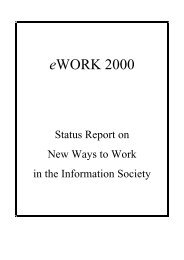Proceedings of 8th European Assembly on telework (Telework2001)
Proceedings of 8th European Assembly on telework (Telework2001)
Proceedings of 8th European Assembly on telework (Telework2001)
Create successful ePaper yourself
Turn your PDF publications into a flip-book with our unique Google optimized e-Paper software.
72Preliminary results <str<strong>on</strong>g>of</str<strong>on</strong>g> the EMERGENCE surveyIn 2000, the EMERGENCE project carried out a survey, <str<strong>on</strong>g>of</str<strong>on</strong>g> over seven thousand establishments inall EU countries plus Hungary, Poland and the Czech Republic. Once the results had been weightedto make them representative <str<strong>on</strong>g>of</str<strong>on</strong>g> all <str<strong>on</strong>g>European</str<strong>on</strong>g> establishments, 49% were found to be practisingeWork. Figure 2 shows the breakdown by type <str<strong>on</strong>g>of</str<strong>on</strong>g> eWork.This shows that the stereotypical employee <strong>telework</strong>er based solely at home is in fact <strong>on</strong>e <str<strong>on</strong>g>of</str<strong>on</strong>g> theleast popular forms <str<strong>on</strong>g>of</str<strong>on</strong>g> eWork. Only <strong>on</strong>e and a half per cent <str<strong>on</strong>g>of</str<strong>on</strong>g> establishments in Europe employpeople to work exclusively from home in this way, although the proporti<strong>on</strong> rises to over 2% in theEU (15). It is much more comm<strong>on</strong> to use the new technologies to support multi-locati<strong>on</strong>al workingby employees, already practised by <strong>on</strong>e <str<strong>on</strong>g>European</str<strong>on</strong>g> employer in ten, a form <str<strong>on</strong>g>of</str<strong>on</strong>g> working much lesslikely to be associated with social isolati<strong>on</strong>. As many again are using n<strong>on</strong>-employees for this work.Nearly <strong>on</strong>e employer in six (17.3%) uses freelances to deliver some form <str<strong>on</strong>g>of</str<strong>on</strong>g> informati<strong>on</strong> service.Using a tighter definiti<strong>on</strong> <str<strong>on</strong>g>of</str<strong>on</strong>g> freelance eWork, to include <strong>on</strong>ly work which is delivered by means <str<strong>on</strong>g>of</str<strong>on</strong>g>telecommunicati<strong>on</strong>s, we still find 11.4% <str<strong>on</strong>g>of</str<strong>on</strong>g> <str<strong>on</strong>g>European</str<strong>on</strong>g> employers are using ’e-lancers’.Turning to eWork carried out <strong>on</strong> <str<strong>on</strong>g>of</str<strong>on</strong>g>fice premises, we find that employers are already makingsignificant use <str<strong>on</strong>g>of</str<strong>on</strong>g> IST technologies to carry work out remotely. One <str<strong>on</strong>g>European</str<strong>on</strong>g> employer in fourteen(6.8%) has a back <str<strong>on</strong>g>of</str<strong>on</strong>g>fice in another regi<strong>on</strong>. Bearing in mind that the ’regi<strong>on</strong>s’ we are talking abouthere are large - NUTS1 level - regi<strong>on</strong>s, which, in the case <str<strong>on</strong>g>of</str<strong>on</strong>g> smaller countries like Ireland, Portugalor Luxembourg, c<strong>on</strong>stitute the whole country, this represents a significant displacement <str<strong>on</strong>g>of</str<strong>on</strong>g> work.To these can be added a further 1% <str<strong>on</strong>g>of</str<strong>on</strong>g> employers who make use <str<strong>on</strong>g>of</str<strong>on</strong>g> telecottages or telecentres asremote bases for their employees.These forms <str<strong>on</strong>g>of</str<strong>on</strong>g> internal <strong>telework</strong>ing are heavily outweighed, however, by the use <str<strong>on</strong>g>of</str<strong>on</strong>g> e-outsourcingas a mechanism for carrying work out remotely. Over half <str<strong>on</strong>g>of</str<strong>on</strong>g> all establishments (56%) outsourceat least <strong>on</strong>e business service involving informati<strong>on</strong> processing. Restricting our definiti<strong>on</strong> <strong>on</strong>ly tothose which use electr<strong>on</strong>ic means <str<strong>on</strong>g>of</str<strong>on</strong>g> delivery (’e-outsourcers’) we find 43% <str<strong>on</strong>g>of</str<strong>on</strong>g> employers makinguse <str<strong>on</strong>g>of</str<strong>on</strong>g> this practice. Much <str<strong>on</strong>g>of</str<strong>on</strong>g> this outsourcing is carried out within the regi<strong>on</strong> where the employer isbased (34.5%) but substantial numbers <str<strong>on</strong>g>of</str<strong>on</strong>g> establishments (18.3%) are outsourcing to other regi<strong>on</strong>swithin the same country, whilst 5.3% are outsourcing outside their nati<strong>on</strong>al borders, as can be seenfrom Figure 2.








